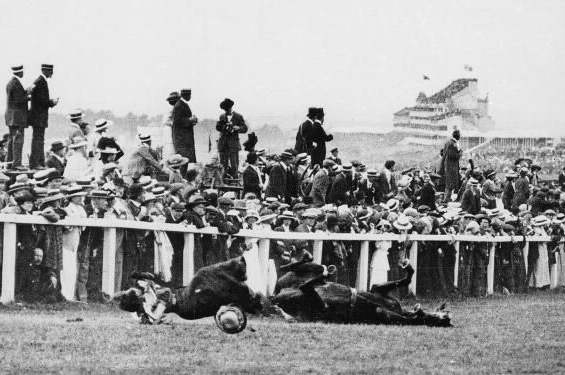Even in the earliest days of the 20th century, the Epsom Derby was the most watched race in Britain. It was prestigious – a national event so monumental that it coined the word ‘derby’ for races worldwide. It was at this event on 4 June 1913, with thousands of people watching, that a lone woman walked onto the track and was struck by the king’s horse. Her name was Emily Wilding Davison, and this single act gripped, astonished and appalled the nation in the days, months and years that followed. While she lay dying, two groups were already waging a battle over her memory. Emmeline Pankhurst’s Women’s Social and Political Union needed her to be their martyr, and were already trying to squeeze the tragedy for every column inch they could get. Meanwhile, the government, aware of how powerful a martyr could be, were quick to brand her a fanatical suicidal maniac.
But what was the truth? We weigh up the arguments for and against suicide.

FOR:
- The idea that Davison simply thought the race had passed by and was walking across the track is disputed by an eyewitness, John Ervine, who commented, “I feel sure that Ms Davison meant to stop the horse, and that she did not go on to the course in the belief that the race was over, for, as I say, only a few of the horses had gone by when I first saw her leave the railings, and others had not passed when she was knocked down.” Another unnamed eyewitness said that “It was obviously her intention to stop the race.”
- This was not the first event in Davison’s life that indicated she was willing to make the ultimate sacrifice for her cause. While in Holloway prison she had thrown herself over the railings twice, very aware that it would likely result in her death. When she was being treated by a prison doctor after one of these attempts in June 1912, she went on record as saying “a tragedy is wanted.”
- Although Emmeline Pankhurst wasn’t in full support of some of Davison’s radical actions, she was convinced that Davison had leapt in front of the horse with the intent of becoming a martyr. In her biography she wrote: “Emily Davison clung to her conviction that one great tragedy, the deliberate throwing into the breach of a human life, would put an end to the intolerable torture of women. And so she threw herself at the king’s horse, in full view of the king and queen and a great multitude of their majesties’ subjects.”
- Many historians are doubtful that Davison’s actions that day were anything to do with other suffragettes. Not only did she campaign independently from the WSPU, but the stories of her practising with horses and drawing straws come from very unreliable sources, and are akin to ‘folklore’. It is more likely that, as usual, Davison was acting alone and nobody was aware of her plans.

AGAINST:
- At the time there was a tradition that once the horses had passed by the crowd, the people would walk onto the course andfollow it down to the finish. It is possible that Davison thought that all the horses had gone past her and was simply attempting to crossthe racecourse. This would explain the ‘calm’ demeanour that she reportedly had, and many at the race believed this was the case.
- There is evidence that Davison had no intention of dying that day at the derby. She had purchased a return rail ticket to Victoria station, and although that was the only type available to purchase, she did keep the return slip carefully stored in her purse. She also had a ticket to a suffragette dance that was taking place later that day on her person. Davison was also due to go on holiday after the derby to visit her sister in France.
- Sylvia Pankhurst, the daughter of Emmeline, disagrees with her mother’s conviction that it was a suicide. She wrote: “She had concerted a derby protest without tragedy – a mere waving of the purple-white-and-green at Tattenham Corner, which, by its suddenness, it was hoped would stop the race. Whether from the first her purpose was more serious, or whether a final impulse altered her resolve, I know not. Her friend declares she would not thus have died without writing a farewell message to her mother.”
- A lot of research has suggested that instead of simply throwing herself in front of the horse, Davison intended to attach a WSPU scarf to it, so the horse would be flying the flag when it crossed the finishing line. This is backed up by the two WSPU flags found in her possession after the incident. In the newsreel footage of the incident, Davison is clearly seen reaching up to the racehorse. There are also accounts that Davison and some other suffragettes were witnessed practising grabbing horses, and also drew lots to decide who should do the job at the derby.
For more incredible stories of women throughout history, pick up the new issue of all About History here or subscribe now and save 25% on the cover price.
